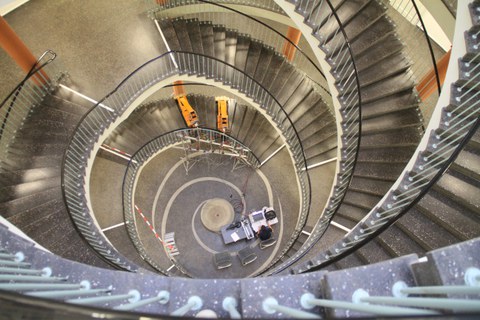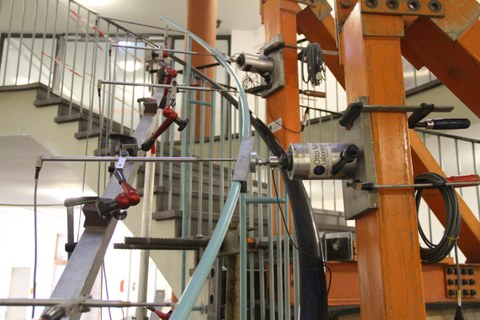Load test to determine experimentally the stability of banisters in the "Hülße-Bau" of the Technische Universität Dresden
Table of contents
Project data
| Titel | Title Belastungsversuche zum experimentellen Nachweis der Tragfähigkeit von Treppengeländern im Hülße-Bau der Technischen Universität Dresden | Load test to determine experimentally the stabilty of the banisters in the ‚Hülße-Bau‘ of the Technische Universität Dresden Förderer | Funding Staatsbetrieb Sächsisches Immobilien- und Baumanagement, Niederlassung Dresden II Zeitraum | Period 04.2019 Leiter | Project Manager Prof. Dr.-Ing. Dr.-Ing. E.h. Manfred Curbach (Institut für Massivbau, TU Dresden), Bearbeiter | Contributors Dipl.-Ing. (FH) Sabine Wellner, Dr.-Ing. Torsten Hampel, Bernd Wehner, Heiko Wachtel |
Report in the annual report 2019
LOAD TEST ON A RAILING IN THE HÜLSSE-BAU

Test set-up at the main staircase
The ‘Hülße-Bau’ of the TU Dresden, with its distinctive pyramidal glass roof, was built between 1902 and 1907 and served as a jail for the neighbouring district court of Dresden (today Schumann-Bau) until 1956. During the Second World War, the building was massively damaged. After the relocation of the district court and the closure of the jail, the building was taken over by the Technical University of Dresden in 1957 and rebuilt according to the plans of the architects Otto Schubert and Georg Münter as an auditorium and office building.
The steel railing of the main staircase, which dates back to this time, had to be increased by about 20 cm for reasons of occupational health and safety. For this purpose, a layout with vertical struts and a handrail made of round steel was installed on the ground floor, which was welded to the existing railing.

Detail of the load application point
The stability of the railing against a horizontal loading had to be proven by an experimental test. For this purpose, two load frames were used, which were each arranged vertically in the middle between two vertical poles of the rehabilitated railing. On each frame, at the level of the handrail, a hydraulic cylinder was mounted, which introduced the load horizontally into the handrail during the test. In order to prevent punctual loading, a fitting for load introduction was used. With one load cell per cylinder, the applied load was controlled. During the load test, inductive distance sensors recorded the deformations.
In total, five load cycles were performed in order to be able to assess the load-bearing behaviour of the rehabilitated railing as well as of the existing railing.
At the rehabilitated railing, the ultimate test load could not be detected due to reaching the maximum load that could be applied. In the load condition, significant deformations of more than 40 mm were recorded. In order to reduce the maximum deformation of the rehabilitated railing, it was recommended to attach a further attachment point in the middle between the already existing attachment points on the existing railing.
